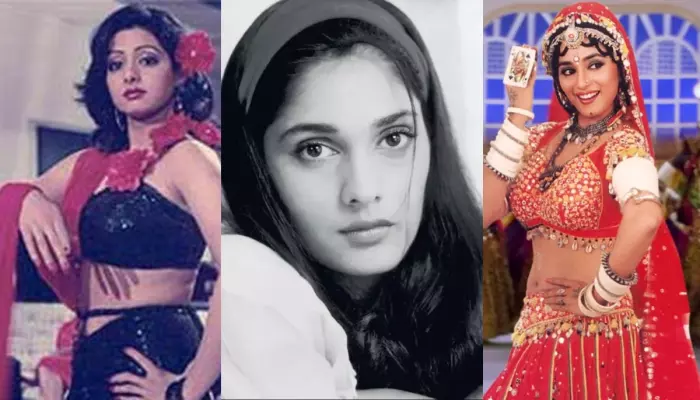By Farru Tech, June 18, 2025
Anu Aggarwal Opens Up on Competing With Madhuri & Sridevi: ‘I Never Did Item Numbers’
"Anu Aggarwal, the iconic star of Aashiqui, opens up about her unique place in Bollywood, her choice to avoid item numbers, and why she never saw herself in competition with legends like Sridevi and Madhuri Dixit. From her meteoric rise to a life-altering accident and her inspiring pivot to spirituality, this blog dives into Anu’s remarkable journey, her bold choices, and her lasting impact on Indian cinema".
A Star Born Overnight

Anu Aggarwal burst onto the Bollywood scene in 1990 with Aashiqui, a romantic musical blockbuster that became a cultural phenomenon. Directed by Mahesh Bhatt, the film’s soulful soundtrack and Anu’s raw, emotive performance as Anu Verghese opposite Rahul Roy made her an overnight sensation. Her journey to stardom was unconventional—born in Delhi on January 11, 1969, Anu was a sociology gold medalist at Delhi University who dabbled in modeling and VJing before landing her debut role in the Doordarshan serial Isi Bahane (1988). Aashiqui catapulted her to fame, but unlike her contemporaries, Anu carved a distinct path, choosing roles that aligned with her vision rather than chasing mainstream glory.
In a recent interview with Filmfare, Anu reflected on her career, addressing whether she felt overshadowed by Bollywood giants like Sridevi and Madhuri Dixit, whose box-office dominance and iconic item numbers defined the 1990s. Her candid response offers a glimpse into a woman who was never swayed by fame’s allure, choosing instead to follow her own artistic compass.
No Competition with Sridevi and Madhuri
The 1990s were a golden era for Bollywood, with Sridevi and Madhuri Dixit reigning as the industry’s leading ladies. Sridevi, already a pan-Indian superstar by 1987 with films like Mr. India and Nagina, was known for her versatility and magnetic screen presence. Madhuri, dubbed the “Ek Do Teen Girl” after Tezaab (1988), rose rapidly with hits like Dil (1990) and Hum Aapke Hain Koun..! (1994), blending girl-next-door charm with electrifying dance numbers. Their rivalry, often fueled by media, was legendary, with Filmfare’s 1993 cover famously headlining their “Clash!”
When asked if she felt overshadowed by these titans, Anu was unequivocal: “Offers could never dry up as there had been no one like Anu Aggarwal.” She emphasized that she wasn’t competing with Sridevi or Madhuri because her cinematic choices were fundamentally different. “Sridevi was the top actress of that time, while Madhuri was the second top actress,” Anu noted, acknowledging their stature. “But the kind of films they did, I didn’t do.” Her focus was on roles that carried meaning, not the commercial masala films or item numbers that defined much of 1990s Bollywood.
Steering Clear of Item Numbers
Anu’s decision to avoid item numbers, like Madhuri’s iconic “Choli Ke Peeche” from Khalnayak (1993) or Sridevi’s sensuous “Hawa Hawaai” from Mr. India (1987), was deliberate. “It was not my style,” she said. “I wanted to do roles that would make a difference.” While she acknowledged her ability to dance, Anu felt item numbers didn’t align with her artistic vision. This choice set her apart in an era when dance sequences were often a heroine’s ticket to fame. For instance, Madhuri’s performance in Tezaab earned her a Filmfare nomination, with her dance in “Ek Do Teen” becoming a cultural milestone, while Sridevi’s Chaalbaaz (1989) showcased her ability to “play with her face,” as choreographer Saroj Khan noted, blending technical prowess with emotive depth.
Anu’s filmography reflected her selective approach. After Aashiqui, she starred in films like Khal-Naaikaa (1993), a psychological thriller, and The Cloud Door (1994), an Indo-German short film that explored sensuality and mysticism. She also appeared in Mani Ratnam’s Thiruda Thiruda (1993), a Tamil-Hindi caper that showcased her willingness to experiment. Unlike Sridevi and Madhuri, who thrived in mainstream hits, Anu gravitated toward offbeat or character-driven roles, even if they didn’t always translate to box-office success.
The Accident That Changed Everything
Anu’s promising career took a tragic turn in 1999 when a near-fatal car accident in Mumbai left her in a coma for 29 days. The accident erased her memories, including those of her Bollywood days. In an interview with the Indian Express, Anu shared the surreal experience of rewatching Aashiqui post-recovery: “My mom played the movie for me, but I couldn’t relate to it at all. I was just looking at the screen like a baby.” When told about Aashiqui 2, she even asked, “What is 2?”—a testament to how the accident stripped away her sense of her past life, including basic concepts like numbers.
The accident marked a turning point. Anu left Bollywood, embracing spirituality and yoga. By 1997, she had already begun studying at the Bihar School of Yoga, living as a karmayogi. After the accident, she deepened her commitment, eventually founding the Anu Aggarwal Foundation to focus on mental health and yoga for underprivileged communities. Today, she teaches yoga in Mumbai’s slums, a far cry from the glitz of Bollywood.
Reflections on Aashiqui and Its Legacy
Aashiqui remains Anu’s defining work, a film whose music and romance still resonate. In a 2025 Pinkvilla interview, Anu spoke about Aashiqui 3, starring Kartik Aaryan and Sreeleela, noting, “The truth is, no one can predict what will resonate with people… The songs from the original Aashiqui are still cherished.” She expressed no judgment about the sequels, appreciating their efforts to capture the franchise’s emotional core.
However, Anu also revealed a lesser-known struggle: she was paid only 60% of her fee for Aashiqui, a claim she made in a 2025 interview with Jansatta, hinting at financial irregularities behind the film’s production. Despite these challenges, Anu’s pride in her unique contribution to Bollywood remains unshaken. “There was no one like Anu Aggarwal,” she reiterated, emphasizing her individuality in an industry often driven by conformity.
A Clash of Titans: Sridevi and Madhuri’s Dominance
To understand Anu’s stance, it’s worth examining the landscape she navigated. Sridevi, who began her career as a child artist, had already starred in over 250 films by age 24, bringing unmatched experience and versatility. Her performances in Chaalbaaz and Lamhe (1991) showcased her ability to blend drama, comedy, and dance, earning her accolades and a massive fanbase. Madhuri, meanwhile, rose to fame with Tezaab and solidified her reign with Hum Aapke Hain Koun..!, which became Bollywood’s highest-grossing film of its time. Her dance numbers, like “Didi Tera Devar Deewana,” inspired trends and merchandise, cementing her as a cultural icon.
The media often pitted Sridevi and Madhuri against each other, with Sridevi’s Khuda Gawah (1992) overshadowed by Madhuri’s Beta (1992) at the box office. Madhuri herself debunked rivalry rumors in a 2024 News18 interview, saying, “We both had a lot of respect and admiration for each other… She was very sweet to me.” Yet, as Javed Akhtar noted in 2024, neither actress received roles as meaty as those of Nargis or Meena Kumari, highlighting the industry’s shift away from women-centric stories in the 1990s.
Anu’s Unique Legacy
Anu’s refusal to conform set her apart but also limited her mainstream success. Unlike Sridevi and Madhuri, who balanced commercial hits with iconic dance sequences, Anu prioritized substance over spectacle. Her post-accident life further underscores her resilience. Today, at 56, she remains a beacon of inspiration, not for box-office numbers but for her courage to redefine success. Her foundation’s work, coupled with her candid reflections on films like Animal and RRR, shows a woman still connected to cinema but on her own terms.
Why Anu’s Story Resonates
Anu Aggarwal’s journey is a testament to staying true to oneself in an industry that thrives on trends. Her decision to avoid item numbers, her survival of a life-altering accident, and her pivot to social good challenge the notion of stardom. While Sridevi and Madhuri ruled the 1990s with their charisma and dance, Anu carved a niche that was uniquely hers. Her story reminds us that success isn’t always measured in crores or chartbusters but in the courage to choose your own path.
As Bollywood evolves, with new stars like Kartik Aaryan carrying the Aashiqui legacy forward, Anu’s legacy endures—not in the spotlight, but in the lives she touches through her foundation and the memories of a film that still makes hearts sing.


